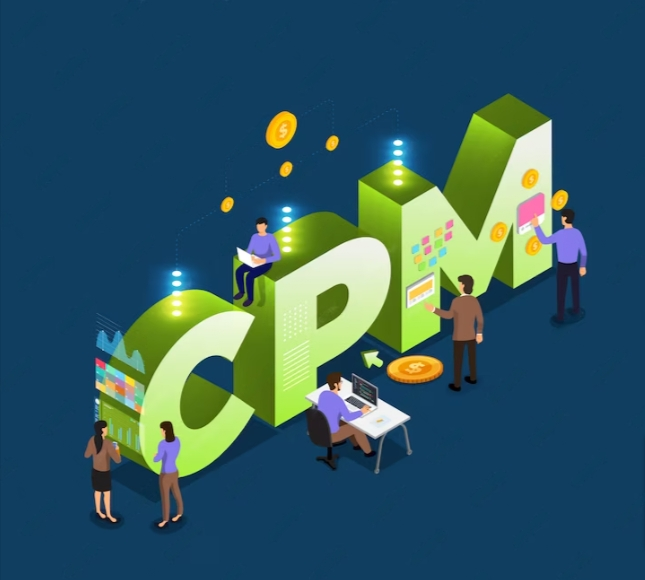Search Engine Marketing (SEM): What It Is & How to Do It Right
Alright, picture this: you’re in a bustling market, surrounded by countless stalls, each trying to catch your eye with their flashy banners and catchy slogans. That’s pretty much Search Engine Marketing (SEM) in the digital world.
Think of SEM as your ticket to stand out in a crowded online marketplace. It’s like putting up your banner right at the top of a search engine results page, grabbing people’s attention when they’re searching for something specific.
Here’s the deal: SEM is all about getting your website in front of people by bidding on keywords. You know, those magical words people type into search engines when they’re hunting for something. When someone searches for those words, your ad pops up, waving hello, hoping to solve their problem or fulfill their need.
And the cool part? You only pay when someone clicks on your ad. It’s like having your shop right at the entrance of the market, and you only pay when someone walks in to take a look.
SEM isn’t just about being seen; it’s about being seen by the right people at the right time. It’s your chance to shine bright in the vast online world and get noticed by those who are actively looking for what you offer.
What is Search Engine Marketing (SEM)?
Defining SEM:
At its core, SEM is a sophisticated digital marketing strategy that leverages paid advertising to amplify a website’s visibility in search engine results pages (SERPs). Distinguishing itself from its counterpart, Search Engine Optimization (SEO), which relies on organic methods, SEM harnesses the power of paid tactics for immediate and strategic exposure.
The Components Unveiled:
- Pay-Per-Click (PPC):
– The bedrock of SEM lies in Pay-Per-Click advertising. This dynamic model allows businesses to bid on keywords relevant to their offerings. The result? Ads that secure premium placement in the sponsored section of search results, with advertisers paying a nominal fee for each user click.
- Display Advertising:
– SEM extends beyond the constraints of text-based ads, venturing into the visually compelling realm of display advertising. Captivating banners and images are strategically placed across the Google Display Network, enhancing the visual appeal and expanding the reach of campaigns.
- Remarketing:
– A tactical extension of SEM involves re-engaging users who have previously visited a website but did not convert. This approach targets them with tailored ads, creating a personalized journey and increasing the probability of conversion upon subsequent interactions.
Why is SEM Important?
Instant Visibility:
In a world where immediacy is paramount, SEM bestows upon businesses the unparalleled advantage of instant visibility. While SEO is a crucial long-term investment, SEM ensures businesses can secure a prime position in search results from the very beginning, fostering a powerful initial impression.
Targeted Advertising:
Precision is the hallmark of SEM. Businesses can meticulously tailor their ads based on demographics, location, devices, and even specific times of the day. This level of targeting ensures that ads are displayed to the most relevant and receptive audience, optimizing the chances of conversion and creating a personalized user experience.
Measurable Results:
The beauty of SEM lies in its measurability. SEM platforms offer robust analytics tools, providing granular insights into campaign performance. Metrics such as click-through rates (CTR), conversion rates, and return on investment (ROI) are not only quantifiable but offer actionable insights for continuous optimization and refinement, ensuring every marketing dollar is wisely spent.
What are some SEM Best Practices?
- Thorough Keyword Research:
– A robust SEM campaign is built on the foundation of meticulous keyword research. Tools like Google Keyword Planner aid in identifying high-performing keywords, striking the delicate balance between search volume and competition.
- Compelling Ad Copy:
– Crafting compelling ad copy transcends mere alignment with business objectives. It involves creating a narrative that resonates with the target audience. A compelling story, coupled with a clear call-to-action (CTA), can significantly impact user engagement and conversion rates.
- Landing Page Optimization:
– The user journey doesn’t conclude with a click; it extends to the landing page. Ensure that these pages are optimized for conversions. The content should seamlessly align with the ad, facilitating a smooth transition towards the desired user action and enhancing overall user experience.
- Budget Management:
– Budgeting is a delicate balancing act. Set a realistic budget aligned with business goals, bid strategically on keywords, and consistently monitor and adjust bids based on performance to maximize efficacy and ROI.
- Ad Extensions:
– Elevate the visibility and appeal of ads by incorporating ad extensions. These additional snippets of information provide users with more context directly on the search results page, potentially increasing click-through rates and overall engagement.
- Conversion Tracking:
– Robust conversion tracking mechanisms are the backbone of effective SEM. Discerning which keywords and ads contribute most significantly to goals empowers data-driven decision-making and continual refinement, ensuring campaigns are perpetually optimized for success.
- Regular Monitoring and Optimization:
– SEM is an iterative process. Regularly reviewing campaign performance, experimenting with new ad variations, adjusting bids, and optimizing based on emerging trends and user behavior is imperative for sustained success in the ever-evolving digital landscape.
- Mobile Optimization:
– Recognizing the ubiquity of mobile devices, ensure SEM campaigns are optimized for this audience. Responsive ad design and mobile-friendly landing pages are instrumental in providing a seamless experience for mobile users, who constitute an ever-growing segment of online users.
What are the common Tools and Platforms for SEM?
Here’s an overview of popular advertising platforms and SEM analytics tools used for performance tracking in Search Engine Marketing (SEM):
Advertising Platforms:
1. Google Ads:
Google Ads is the kingpin of SEM, offering ads across Google’s search network, display network, YouTube, and more. It uses a pay-per-click (PPC) model and allows advertisers to bid on keywords, create various ad formats, and target specific demographics, locations, and devices.
2. Bing Ads:
Bing Ads, powered by Microsoft Advertising, functions similarly to Google Ads. It serves ads on Bing search, Yahoo, and Microsoft’s partner networks. It offers PPC advertising and allows for targeting options akin to Google Ads.
3. Facebook Ads:
While primarily a social media platform, Facebook offers a robust advertising platform. It enables precise audience targeting based on demographics, interests, behavior, and more. Ad formats include image ads, video ads, carousel ads, and more, optimizing for various campaign objectives.
4. LinkedIn Ads:
LinkedIn Ads caters to B2B marketing, offering precise targeting based on job titles, industries, company sizes, and professional demographics. It provides sponsored content, message ads, and sponsored InMail.
SEM Analytics Tools:
1. Google Analytics:
Google Analytics tracks website traffic, user behavior, conversions, and more. It provides insights into the performance of SEM campaigns, helping in understanding user engagement, bounce rates, and conversion paths.
2. SEMrush:
SEMrush offers a suite of SEM and SEO tools, providing insights into keyword research, competitor analysis, ad strategies, and backlink analysis. It aids in identifying profitable keywords and monitoring competitors’ ad campaigns.
3. Ahrefs:
Primarily an SEO tool, Ahrefs includes features for keyword research, backlink analysis, and site auditing. It helps in understanding competitor strategies and identifying keyword opportunities for SEM campaigns.
4. SpyFu:
SpyFu specializes in competitor analysis, providing insights into competitor keywords, ad copy, and ad spend. It assists in uncovering profitable keywords and ad strategies of competitors.
These platforms and tools play a crucial role in managing SEM campaigns, enabling advertisers to create, monitor, and optimize their ads for better performance and ROI.
What are the Common Mistakes to Avoid in SEM?
Steering clear of common pitfalls in Search Engine Marketing (SEM) is key to running successful campaigns. Here are a couple of significant mistakes to avoid:
1. Overlooking Negative Keywords:
Neglecting negative keywords is like allowing unwanted guests into your party. These keywords prevent your ads from showing up for irrelevant searches. Not utilizing negative keywords could lead to your ad showing up for searches that don’t align with your offerings, wasting your budget and reducing conversion rates. By identifying and adding negative keywords, you refine your targeting and ensure your ad appears in more relevant searches, increasing the chances of attracting qualified leads.
2. Ignoring Ad Relevance and Quality:
Quality matters, even in the digital ad world. Ignoring the relevance and quality of your ads can hurt your campaigns. Low-quality ads, irrelevant ad copy, or landing pages that don’t match the user’s search intent can result in lower click-through rates (CTR), higher bounce rates, and a drop in ad positions. It’s crucial to create highly relevant ad copy, use targeted keywords, and ensure your landing pages deliver what your ad promises. This boosts ad quality, improves user experience, and enhances the chances of conversions.
3. Neglecting Ad Extensions:
Ad extensions are like bonus features for your ads. Neglecting to use them means missing out on opportunities to enhance your ad’s visibility and engagement. Extensions like site links, callouts, structured snippets, and call extensions provide additional information, making your ad more compelling and informative. Ignoring these extensions limits your ad’s potential to stand out and grab users’ attention, potentially leading to lower CTRs and reduced ad performance.
4. Lack of Continuous Optimization:
SEM isn’t a ‘set-it-and-forget-it’ deal. Failing to continuously optimize your campaigns can hinder their performance. Constantly monitoring and refining your keywords, ad copy, bidding strategy, and targeting parameters is crucial. Without regular optimization, you might miss opportunities to improve campaign performance, maximize ROI, and stay ahead of changing market trends or shifts in user behavior.
5. Disregarding Ad Testing:
Not testing different ad variations means missing out on discovering what resonates best with your audience. A/B testing ad copies, headlines, images, or CTAs is essential to understand what drives better engagement and conversions. Without testing, you might overlook valuable insights that could significantly improve your ad performance.
6. Ignoring Mobile Users:
With a growing number of users accessing the internet via mobile devices, ignoring mobile optimization in your SEM strategy is a significant misstep. Failing to create mobile-friendly ads or landing pages can lead to poor user experiences, lower CTRs, and missed opportunities to connect with potential customers browsing on mobile.
Steering clear of these mistakes involves continuous monitoring, adapting strategies, and staying responsive to changes in the digital landscape. By addressing these aspects, you enhance your SEM campaigns, optimize performance, and increase your chances of achieving campaign objectives.
Wrap Up
In essence, Search Engine Marketing remains a pivotal force in the digital marketing toolkit. It not only offers businesses the means to survive but provides the impetus to thrive online. By comprehending the components, recognizing the benefits, and adhering to the best practices outlined in this guide, businesses can harness the full potential of SEM. This powerful strategy propels online visibility, drives targeted traffic, and, most importantly, helps achieve overarching business objectives. As the digital landscape continues to evolve, SEM stands firm as a catalyst for businesses seeking immediate and measurable results in the fiercely competitive






